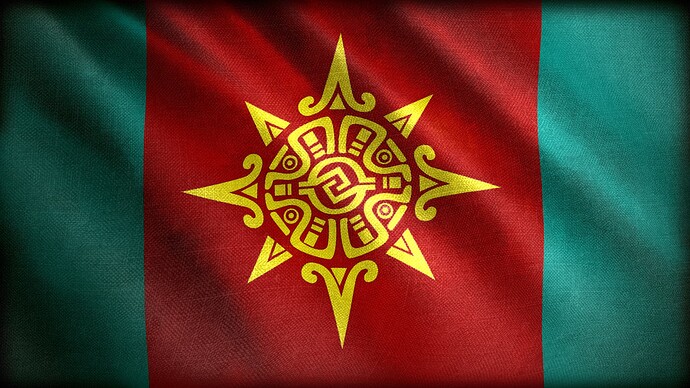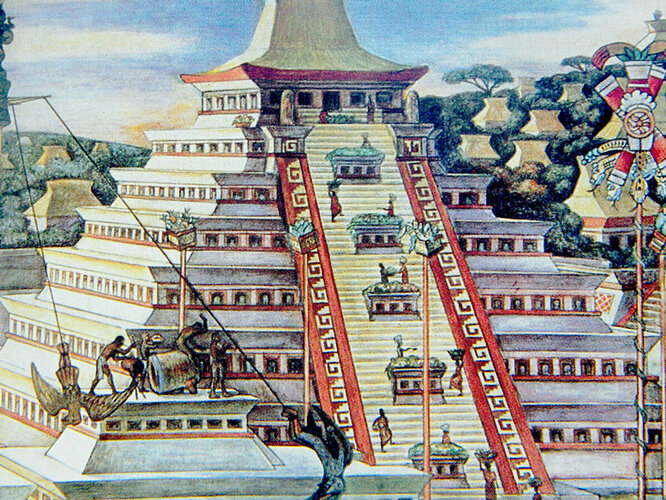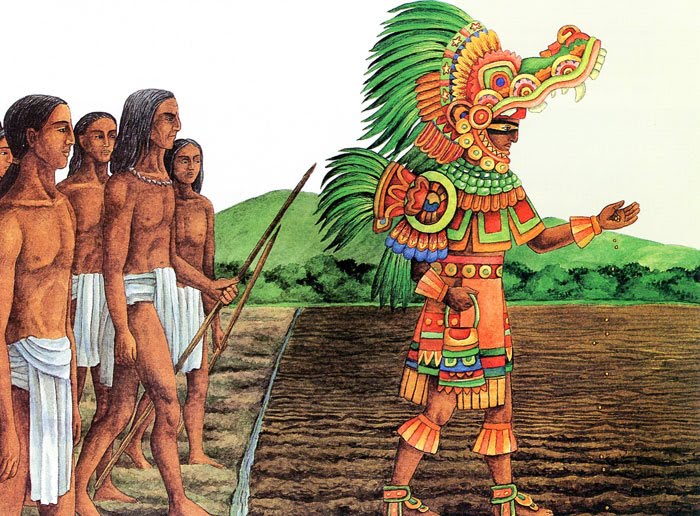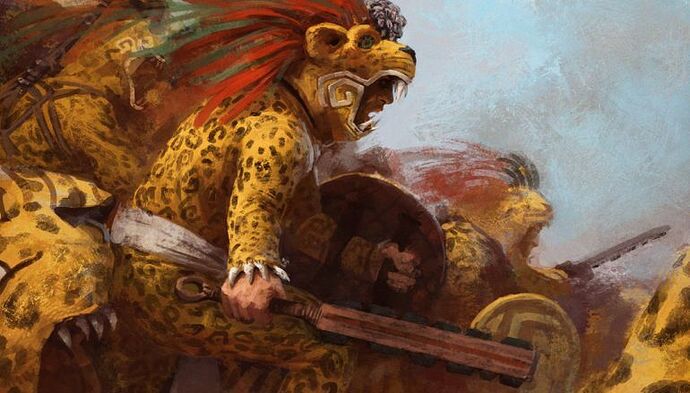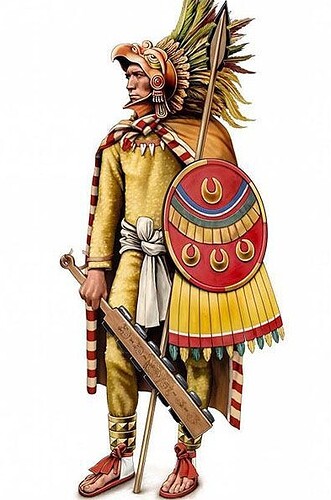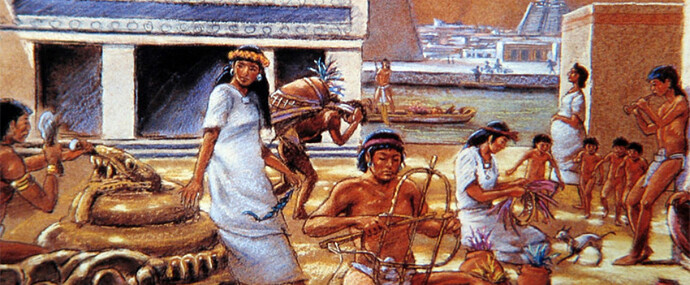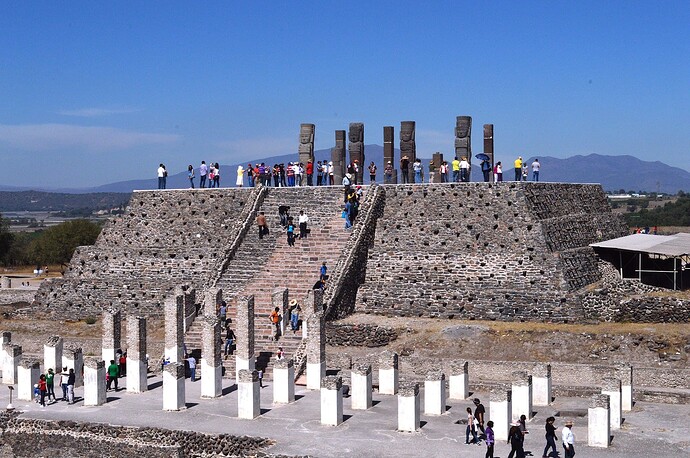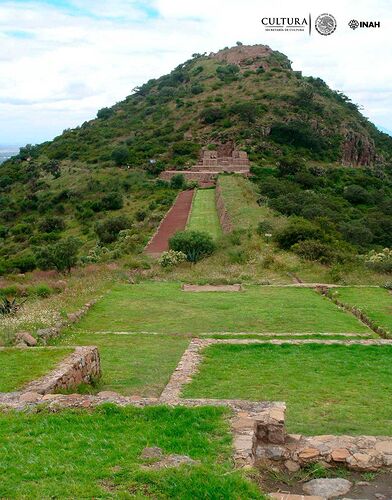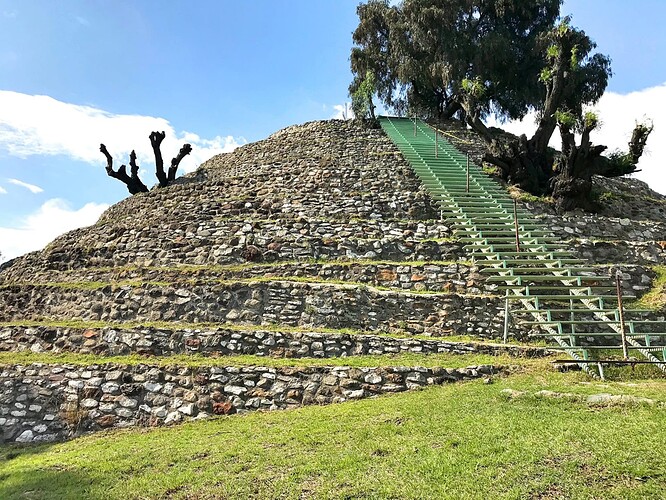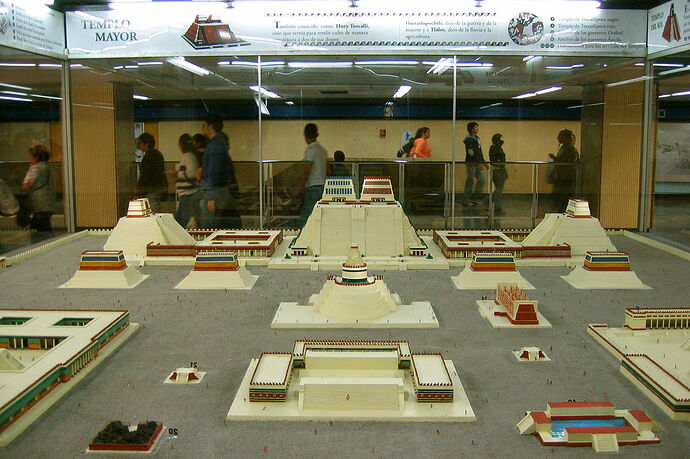Aztec
The Aztec empire
Religion, Promotion, Infantry
Difficulty: 3/3
Bonuses
- All infantry can gather offering from unit kills.
- Villager carry capacity +5
- Religious unit gain +5 Hitpoint for every religious tech reserached.
- Military production speed increased by 15%, and gains additional 15% for each age up.
- Relics generate 33% more gold.
- Unique Building: Calmecác
- Unique Building: Telpochcalli
- Unique Building: Tchinapl
- Unique Building: Teocalli (Replaces Monestary)
- Unique Unit: Tlamacazui (Replaces Monk)
- Unique Unit: Jaguar Warrior variant
- Unique Unit: Eagle Warrior variant.
- Unique Unit: Tlaxcalan Cauallero
Meritocracy**:** Units are able to be promoted into Eagle or Jaguar warrior variant by killing 4 units by a Tlamacazui religious unit. Promotion fully replenish the units HP.
Killing enemy units grants Offering resource.
Devine sacrefice: Teocalli can use Offering resource to promote units into Eagle and Jaguar units, Through Sun tribute or Night tribute.
Is also able to globally boost food production for 10 seconds per Offering.
Unit Rooster:
- Age I: Pathfinder
- Age I: Spearman
- Age II: Archer
- Age II: Slinger
- Age II: Tlamacazui (Unique)
- Age II: Atlatl
- Age III: Macuahuitl
- Age IV: Tlaxcalan Cauallero (Landmark Unique)
- Jaguar Spearman (Unique)
- Jaguar Archer (Unique)
- Jaguar Slinger (Unique)
- Jaguar Atlatl (Unique)
- Jaguar Macuahuitl (Unique)
- Eagle Spearman (Unique)
- Eagle Archer (Unique)
- Eagle Slinger (Unique)
- Eagle Atlatl (Unique)
- Eagle Macuahuitl (Unique)
- Age II: Siege Platform
- Age III: Siege Pyre (Platform Variant)
- Age II: Siege Tunneler (Platform Variant)
- Age II: Siege Tower (Platform Variant)
- Age III: Siege Mantlet (Platform Variant)
- Age I: Fishing Canoe
- Age II: Trade Canoe
- Age II: Light Canoe (Melee Ship)
- Age II: War Canoe (Archer ship)
- Age III: King Canoe (Attack Ship)
- Age III: Fire Canoe (Demoship)
Building Rooster:
- Age I: House
- Age I: Mining Camp
- Age I: Lumber Camp
- Age I: Farm
- Age I: Mill
- Age I: Telpochcalli – House of Youth (Unique)
- Age I: Outpost
- Age I: Palisade Gate
- Age I: Palisade Walls
- Age I: Siege Ladders
- Age II: Calmecác – House of Tears (Unique)
- Age II: Docks
- Age II: Tchinapl (Unique)
- Age II: Market
- Age II: Town Center
- Age II: Craftsman Hut
- Age II: Stone Wall Tower
- Age II: Stone Wall Gate
- Age II: Stone Wall
- Age III: Teocalli (Unique)
- Age III: Keep
Technology Rooster:
Mill
- Age I: Survival Techniques
- Age I: Wheelbarrow
- Age II: Horticulture
- Age III: Fertilization
- Age IV: Precision Cross-Breeding
- Age IV: Metate
Lumber Camp
- Age I: Forestry
- Age II: Double Broadaxe
- Age III: Lumber Preservation
- Age IV: Crosscut Saw
Mining Camp
- Age II: Specialized Pick
- Age III: Acid Destilization
- Age IV: Cupellation
Town Center
- Age II: Textiles
- Age II: Temazcal
Telpocalli
- Age I: Yolteotl
- Age II: Blowgun
- Age II: Compass
- Age III: Bloodbath
- Age III: Eagle Dive
- Age IV: Jaguar Fury
- Age IV: Eagle Strike
Tambo
- Age II: Arrow Slits
- Age II: Fortify Outpost
- Age III: Atlatl emplacement
- Age III: Tower Altar
- Age IV: Slinger Platforms
Craftsman hut:
- Age II: Siege Engineering
- Age II: Fitted Leatherwork
- Age II: Thick Woven Capes
- Age II: Obsidian Arrows
- Age II: Obsidian Edges
- Age III: Insulated Helm
- Age III: Quilted Cotton
- Age III: Balanced Projectiles
- Age III: Turtle dung glue
- Age III: Military Academy
- Age III: Chimelli Shields
- Age IV: Salt Brine Coating
- Age IV: Master Smiths
Calmecác
- Age II: Herbal Gardens
- Age III: Universal Education
- Age III: Burning Chili Bomb (Unique)
- Age IV: Flower Wars
- AgeIV: Elite Army Tactics
- AgeIV: Incendiary Arrows
- AgeIV: Court Architects
- AgeIV: Siege Works
- AgeIV: Geometry
Docks
- Age II: Extended Lines
- Age II: Additional Sails
- Age II: Additional Oars
- Age III: Drift Nets
- Age III: Armored Hulls
- Age III: Navigator Lookout
- Age IV: Flattened Hulls
- Age IV: Protective Canoe planking.
Temple
- Age I: Piety
- Age III: Herbal Medecine
- Age III: Blood Rites
- Age IV: Tithe Barns
Keep
- Age III: Boiling Oil
- Age III: Javelin emplacements
- Age IV: Slinger Platforms
*Common
*Native American
*Civilization Unique
Unique Landmarks
Feudal Age:
- Cuicalli: Reduces cost and production speed to nearby buildings by 15% for each age up.
- Toltec Warriors of Tula: Military units who move near this landmark gain permanent 15% movement speed.
Castle Age:
- Tlachtli: Generates a constant stream of offering and gold. Has a special ability to buy Vouchers. Once the first Voucher has been bought, after 2 minutes, one has a chance of getting double the Voucher value in return. Several vouchers can be bought for gold while the ability is active. One can garrison up to 10 military units to increase the chance of winning.
- Acatitlan Teōcalli: Functions as a Teōcalli but with double, the effect of consuming garrisoned units, Reducing the cost of Tlamacazui by 50%.
Imperial Age:
-
Palace of Nezahualcóyotl: Functions as a keep, Calmecacs and Telpochcalli built within its influence radius automatically create promoted infantry units, Eagle and Jaguar variants.
-
**The Spiral Pyramid: Allows production of Tlaxcalan Horsemen with a 400% Production speed, and has Unique Upgrades. Calmecac built within its radius can also produce Tlaxcalan Horsemen.
Wonder: Huēyi Teōcalli
Unique Buildings:
- Telpochcalli (Age I, 150W): Functions as a Military production building, able to train, Spearmen, Slingers and Atlatl, is able to research unique upgrades.
-
Calmecac (Age II, 150W): Function as a Research and Military building. Able to produce Archers and Macuahuitl as well as Tlamacuzui Religious units.
Is able to research unique upgrades and University upgrades in Age IV. - Tchinapl (50W 50S): Fishing boats are able to produce Farms on water, these floating farms has the same gathering rate as deepwater fish, but only 1 fishing boat can harvest from it.
-
Teocalli (300S):
Functions as a religious building that can store relics. Units garrisoned into the Teocalli will be turned into Offerings. Teocalli has a ability: Blood Ritual that makes the Teocalli count as having 1 relic stored for consuming 1 offering every minute. Relics stored in Teocalli’s grants 50 of each resource and 100 gold per minute.
Teocalli is also able to Promote nearby infantry units automatically by activating Temple of the Sun or Temple of the Night ability, at the cost of 4 offerings per unit.
Unique Units:
-
Tlamacazui (Age II, 150G):
A religious unit that is able to heal and promote infantry units into Jaguar or Eagle warriors through their Priest/Pirestess of the Sun (Eagle) or Priest/Priestess of the Night (Jaguar) ability active. Promotion happens to any non-promoted unit that has 4 or more kills.
-
Jaguar Variant(Age II, 4 kills / 4 Offerings):
Jaguar promotion grants unit Stealth ability when standing still, as well as Life-leech ability when doing damage to enemie units, their attack speed increase by 10% for every 5 seconds in combat up to a maximum of 30%.
-
Eagle Variant(Age II, 4 kills / 4 Offerings):
Increases line of sight of unit as well as movement speed by 25%. Gain a Sprint ability, doubling their movement speed for 5 seconds, and causing their first attack to do double damage while the ability is active.
- Tlaxcalan Cauallero(Age IV, 120F 30W): Does bonus damage to archers, their first attack being a ranged Atlatl attack.
Unique: Technologies
- Yolteotl (Age I, 75F 75G): Increases HP by 15% to all none siege units. Upgraded at Telpocalli
- Compass (Age I, 25S 25G): Pathfinder movement speed increased by 10%. Upgraded at Telpocalli.
- Herbal Gardens (Age II, 200F 100W): Increases healing done by Tlamacazui. Upgraded at Calmecác
- Temazcal (Age II, 300W, 100G): Towncenter heal nearby units out of combat. Upgraded at Towncenter
- Bloodbath (Age III, 150F 150G): Jaguar Warriors gain life leech on their attacks. Upgraded at Telpocalli
- Eagle Dive (Age III, 150W 150G): Eagle Warriors gain sprint, increasing their movement speed by 15% for 10 seconds. Upgraded at Telpocalli
- Universal Education (Age III, 250F 250G): Research speed increased by 50%. Upgraded at Calmecác
- Burning Chili bomb (Age III, 300F 250W): Slingers gain an ability that causes their next attack to cause an area of effect that any unit or building gets blinded for 5 seconds when inside it. (Blinded units or buildings do not get blinded again for the next 30 seconds). Upgraded at Calmecác
- Jaguar Fury (Age IV, 400F 300G): Jaguar Warrior gets 10% increased attack speed for every 5 seconds in combat to a maximum of 30%. Upgraded at Telpocalli
- Eagle Strike (Age IV, 400W 300G): Eagle Warrior does double damage on their first attack, which stuns the target for 1 second. Upgraded at Telpocalli
- Flower Wars (Age IV, 300F 700G): Doubles the Offering gathered from killing enemies units and setting buildings on fire. Upgraded at Calmecác
- Metate (Age IV, 250S 350W): Farms and Tchinapl drop off 10% more food. Upgraded at Mills
Additional Notes:
Architecture: Legend tells us that the first building constructed in Tenochtitlan was the temple honoring the Aztec god(H)Uitzilopochtli. We know that the Valley of Mexico was heavily populated at this time, and many of the surrounding towns had public buildings. Many of these buildings were temples. We also know that Tenochtitlan was well planned, and its aqueducts, roads, canals, and buildings were constructed by highly skilled masons. The Aztecs used limestone rocks and adobe bricks in their construction. Houses all had inner courtyards, they were painted white, and had flat thatched roofs. Only the nobility were allowed to have two stories.
Naval units: Early Spanish writers commented on the fact that the lakes all round the Aztec capital were peppered with canoes of all shapes and sizes: carrying goods to and from the city (and especially the great market at Tlatelolco), removing waste, ferrying warriors and raiding parties and - as in Venice - doing many of the every-day transport jobs now carried out in cities by buses and lorries. River/lake/canal transport is a very efficient means of getting goods from A to B. In a society without wheeled vehicles or draft animals, the canoe played a crucial role in moving heavy loads. Indeed, the growth of Tenochtitlan and Tlatelolco into one of the world’s largest cities was certainly due in part to the huge success of the fast-moving, largely water-bound, traffic to and from the main market. Most general purpose canoes averaged 14 feet in length, were dug out from a single tree trunk and with upturned ends, and were propelled by wooden pole (or paddle). At the other extreme, the largest canoes, made of straight-grained spruce trees, were 50 or more feet in length, capable of carrying either 60 passengers or 3 tons of maize. Little wonder that the Náhuatl word for canoe was acalli or ‘water-house’, from the two words atl (water) and calli or house: the Spanish noted that Aztec boatmen would often sleep in their travelling canoes on long journeys
Language progression:
The Aztecs would speak the Nahuatl Language, although it hard to point out exactly how the langauge developed. There is a recorded difference between what was termed Paleonahua and Neonahua. The Paleonahua developed over several centuries, beginning its process of change during the Teotihuacan era, being more conservative in eastern Mesoamerica. Neonahua, however, arose when the Toltec-Chichimecs spread throughout much of the Valley of Mexico, with linguistic innovations such as the addition of the sound /tɬ/.
Landmark references:
-
Cuicalli:
Translated into House of Song, it was the place where boys and girls gathered to relax in the evening, meet and make friends and have fun. Becoming an important center for cultural learning. -
Toltec Warriors of Tula:
Also known as the Atlantean Figures, are four anthropomorphic statues belonging to the Toltec Culture. Built on top of the Pyramid known as Tlahuizcalpantecuhtli as they are said to represent warriors, possibly soldiers following the god-king Quetzalcoatl. Quetzalcoatl, also called the Feathered Serpent, is associated with Venus; as the story goes when he died here on earth he went up to the sky and became the Morning Star. The name of the pyramid – Tlahuizcalpantecuhtli – means “The Temple of the Morning Star.”
The Aztecs revered the Toltec culture as part of their ancestral heritage and also built their own version of statues within their capital of Tenochtitlan. -
Tlachtli:
Was the field the Aztecs played their game called Ollama. It was played by the Aztec forebears, the Mayans, but in Aztec society, the game received an elevated status and was played only by the nobles. As with many other things in Aztec society, the game could get extremely violent. Instead of a halftime show, human sacrifices were involved in the Ollama ritual. Additionally, they were allowed to try to rob the spectators whenever one team scored. The other way in which the audience participated in Ollama was through betting, which they apparently did quite heavily. In fact, two of the great evils Aztec children were warned about were excessive ball playing and gambling. Nonetheless, there are reports of Aztec citizens betting so heavily on the game that they were forced to sell themselves into slavery to pay their debts. -
Acatitlan Teōcalli:

The Temple used to be a part of a political and religious center of the time, later annexed by the Mexica and became part of the lacustrine culture under the rule of Tenochtitlan.** -
Palace of Nezahualcóyotl :
The palace also served as a government meeting center, and contained administrative rooms such as courtrooms for nobles and commoners, council chambers for accomplished warriors, rooms for storing tribute, armories filled with weapons, rooms that housed all manner of servants and caretakers, and also quarters decked out to house visiting rulers. Indeed, the palace was meant to impress and intimidate royal visitors, whether friendly allies or fierce enemies. But it was also a pleasant place, with gardens, ponds, an aviary, and a zoo. Such a center required the presence of a huge number of people: Hernán Cortés tells us that more than 600 nobles appeared in this palace daily, and their servants overflowed two or three of the palace’s large courtyards. -
The Spiral Pyramid:
is a part of the of Xochitécatl temple complex, which was the center of the Tlaxcalan Nation. Xochitécatl means “Place of the Flower Lineage”. The Tlaxcalan was the first Aztec or more precisely, Nuahatl nation to ally with the Spanish, and due to their loyalty, high-status Tlaxcalan would be given Spanish weapons and trained in using horses.
The Spiral Pyramid was built around 700BC and is unlike any other Temples of the region, having no Staircases and being built in a conical shape resembling Popocatépetl, and is considered a representation of the volcano. However the Aztecs dedicated these spiral pyramids to the God of Wind, Ehécatl, one of the creator gods, sometimes interpreted as a form of Quetzacoatl. Since the wind blows from every direction, they associated Ehécatl with all the cardinal directions. They built his temple as a circular pyramid to reduce the air resistance, so he could fly around it without obstacles.
The Spanish placed a cross on top of the Temple in 1632 after the conquest of the Aztec Empire.
Wonder:
-
Huēyi Teōcalli:
Also known as Templo Mayor, The Temple was dedicated simultaneously to Huitzilopochtli, god of war, and Tlaloc, God of Rain and Agriculture. Each of which had a shrine at the top of the pyramid with seperate staircases, and served the main temple of the capital Tenochtitlan.
Unique Unit:
Tlamacazui:
- Health: 90
- Attack:
- Rate of Fire:
- Armor:
- Pierce Armor:
- Speed: 1.13
Note: Has 2 abilities: Priest/Priestess of the Sun, and Priest/Priestess of the Night. When the ability is active, the Tlamacazui will promote any units into an Eagle (Sun), or a Jaguar (Night) whenever they have killed 4 units. When a unit is promoted they regain full health.
Tlaxcalan Cauallero:
- Health: 235
- Attack: 15 Melee (Macuahuitl); 25 (Atlatl); +13 vs Ranged; +10 vs Siege.
- Rate of Fire: 1.38s (macuahuitl);
- Range: 4.5 tiles (Atlatl)
- Armor: 0
- Pierce Armor: 3
- Speed: 1.88 tiles/s
Note : Unit does a Atlatl attack on their first attack which is a ranged attack.
Write-up:
Aztec history has a lot of surprices, and is quite often a misunderstood history.
People have a tendency to sum up that the Aztec was 1 sole entity, but it was far from it.
And it was the very reason why the empire fall as fast as it did, it wasn’t only due to the Spaniards being technologically Overpowered. But because the Aztecs had managed to create a lot of emnity among their neighbours. And the Spaniards were merely the catalyst needed to overthrow the otherwise militarily superior Aztecs, or to be more exact, the Mexica-empire. Yes the name Mexico derives from what the Aztec called themselves: Mexica. As Aztecs was a term coined by the Europeans.
So all that was needed by the spaniards was to rally all the Nations which have been wronged by the Aztec empire to rise up against them.
Now with the 2 new civs of Ottomans and Malians having been announced by MS/Relic. They really showed how far one can push the boundries of the game.
New mechanics are getting added and even a full custom unit rooster (for the Malians).
This is something I’ve always had in mind for the Native-American civilizations. And now this brings bigger hope that these civ’s actually can be added to the game, as developters are willing to push the boundries.
The Malians were never a gunpowder civilization, infact, much like the Native-Americans, despite all their wealth, they never managed to obtain Gunpowder weaponry, despite them constantly seeking it out.
So for the gameplay on the Aztecs I wanted to focus on the Aztec warrior culture, Eagle warriors weren’t just men who ran really fast represented by AoE II and III.
But they were warriors equal if not a higher status of the more famous Jaguar warrior.
Infact the weaponry were the same between Jaguar and Eagles, and the only difference was the God that they represented and quite often their social status, Eagle warrior stemming mostly from nobiltiy while Jaguars were commoners.
In Aztec culture, Everyone (Except for females) Were trained to be a warrior.
And the way to become a Eagle or Jaguar warrior was to have gone out in battle and bring back 4 captives. Only then was one worthy to be a Eagle or Jaguar warrior.
The Jaguar and Eagle warriors are essentially boosted up regular units but with unique abilities ontop of it all.
The Eagle Warrior gets its signature mobility bonus, but also a charge attack.
While the Jaguar becomes someone who specialised in setting up ambushes and thrives in prolonged fights.
The Eagle and Jaguar warriors also believed that by donning the Eagle or Jaguar looks, they would inherit the fighting prowess sof the animal they represented.
Religion also played a very important aspect which is where their Unique Religious unit, Tlamacazui and their Unique Monestaries; Teōcalli, comes into play, converting units into Jaguar or Eagle warriors.
They also get access to their own Unique Horseman, the Tlaxcalan Cauallero.
The Tlaxcalan were of Aztec culture, but a victim of the Aztec flower war, they were being farmed by the Aztec triple alliance (what we recognize the as the Aztec Empire), for sacrefice. So when the Spaniards arrived, they were among the first to ally up with the spaniards despite having fought against them at their arrival.
They became quite loyal to the spanish, as well they played a key part in the spanish conquest of the Aztec Empire, that the Spaniards saw them as a higher class Natives in the americas, and gave them unique privileges in the spanish empire as well as training them in the use of Horses and providing them steel weaponry and armor, which quickly became a status symbol among hte Tlaxcalans.
Next up: Mayans or Incas. IDK. You choose.
AoE4 Civ Concept: Maya
AoE4 Civ Concept: Inca
Basis for Native Americans for further details of other non-unique units:
Native American Basis
